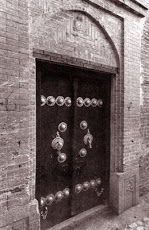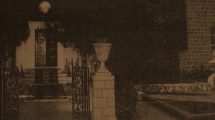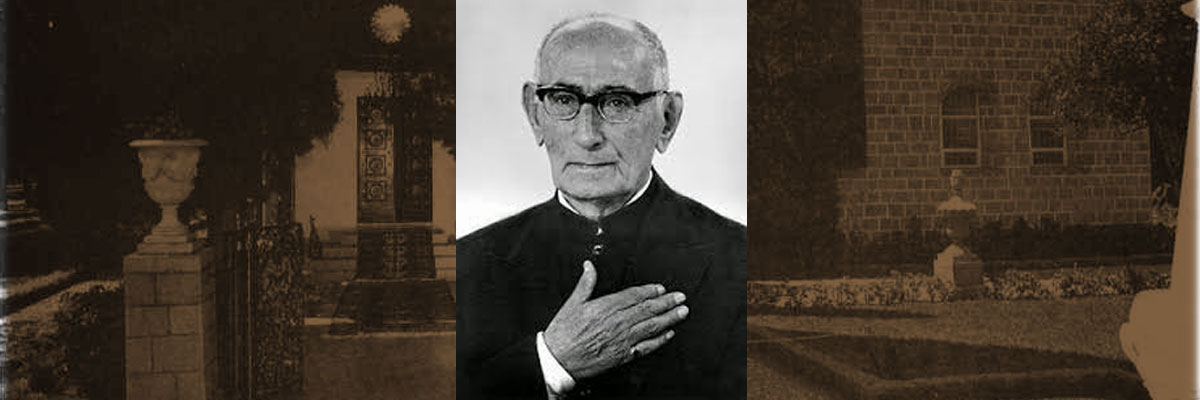 Mullá ‘Alíy-i-Bastamí, Letter of the Living
Mullá ‘Alíy-i-Bastamí, Letter of the Living
Born: Unknown
Death: December 1846
Place of Birth: Bastam, western part of Khurasan, Province of Iran
Location of Death: Istanbul, Turkey
Burial Location: No cemetery details
Mullá ‘Alí received his primary education in Bastám, married there, and had children.
In Mashhad, where he completed his education, he became known for his sincerity and his zeal in investigating religious matters.In the course of his studies, Mullá ‘Alí learned about the Shaykhí movement of Shia Islam from Mullá Ja‘far Kirmánsháhí, one of the Shaykhí ulama (religious scholars) of Mashhad. Mullá ‘Alí was immediately attracted to the movement and soon entered into communication with its leader, Siyyid Kázim Rashtí. Eventually, Mullá ‘Alí left his home and family to study under Siyyid Kázim in Karbala, an important center of Shiite scholarship in Iraq and the seat of the Shaykhí movement.
After seven years Mullá ‘Alí’s father and other relatives, distressed by his long absence, went to Karbala and obtained Siyyid Kázim’s approval for the eager scholar to return home. Mullá ‘Alí was unable to settle down, however, and less than two years later had given up village life and returned to Karbala.
Mullá ‘Alí was among those who accompanied Siyyid Kázim Rashtí on his last pilgrimage to Kázimayn and was in Karbala when Siyyid Kázim died at the end of 1843. Because Siyyid Kázim had not appointed a successor, his death caused a crisis in the Shaykhí community. After several weeks of indecision, some of the disciples, including Mullá Husayn Bushrú’í and Mullá ‘Alí, retired to the mosque of Kufa for forty days of fasting and prayer, a customary Shaykhí practice. They then decided to set off in search of the new leader to whom Siyyid Kázim had alluded.
Mullá ‘Alí reached Shiraz a short time after Mullá Husayn Bushrú’í had recognized the Báb and become His first disciple. According to the historian Nabíl in The Dawn-Breakers, Mullá ‘Alí, realizing that Mullá Husayn had found the object of his search, retired to fast and pray for guidance, during which time he was led to the Báb by a vision. The Báb gave Mullá ‘Alí the title “the Second Who Believed” (Thání Man Ámana) and named him one of eighteen disciples or “Letters of the Living.” The Báb, in His Persian Bayán, identified Mullá ‘Alí, in allegorical language, as the return of the Imam Ali.
The companions with whom Mullá ‘Alí had traveled to Shiraz (twelve, in Nabíl’s account) soon recognized the Báb and were numbered among the Letters of the Living. They spent a short period in His company before He dispersed them, instructing them to disseminate His cause.
The Báb chose Mullá ‘Alí to announce the advent of the Mahdi (but not the Báb’s identity) in the shrine cities of Najaf and Karbala in Iraq, where the most important Shiite clerics were based. According to Nabíl, the Báb sent Mullá ‘Alí on his mission with words of encouragement that alluded to the difficulties he would soon face: “You are the first to leave the House of God [Shiraz], and to suffer for His sake.“
Mullá ‘Alí set out according to the Bab’s special instructions. He went first to Bushehr, where he met with the Báb’s uncle Hájí Mírzá Siyyid Muhammad, who years later accepted both the Báb and Bahá’u’lláh. By the late summer of 1844, Mullá ‘Alí had arrived in Najaf, the site of the shrine of the Imam Ali and a center of Shiite scholarship. There he delivered a message from the Báb to Shaykh Muhammad Hasan Najafí, the foremost mujtahid (a preeminent Shiite scholar and doctor of Islamic law) of the day. The message was abruptly rejected and Mullá ‘Alí expelled from the city.
Mullá ‘Alí proceeded to Karbala, where he spread the writings of the Báb especially among the Shaykhís, many of whom accepted the message. The messianic fervor and controversy that resulted from Mullá ‘Alí’s activities were so great that they were reported in the dispatches of the British consul in Baghdad. One of the Shaykhís in Karbala who heard about the Báb’s advent from Mullá ‘Alí was Fátimih Umm-Salamih Baraghání—later known by the title Táhirih (the Pure One), given to her by the Báb, and the only woman among the Letters of the Living.
The Shiite ulama in Karbala had Mullá ‘Alí arrested and transferred to Baghdad. Najib Pasha, the governor of Baghdad, convened the most prominent of the Sunni and Shiite ulama on January 13, 1845 to try Mullá ‘Alí. Among those gathered were Shaykh Mahmúd al-Álúsí, the mufti (Muslim legal authority) of Baghdad; nineteen other Sunni ulama; Shaykh Hasan ibn Káshifi’l-Ghitá’, the leading Shiite figure after Shaykh Muhammad Hasan; Siyyid Muhammad Báqir Qazvíní, the foremost cleric in Karbala, who had been the bitter enemy of Siyyid Kázim; Shaykh Hasan Gawhar, a leading Shaykhí; and five other Shiite ulama.
Accounts of the proceedings are confused and contradictory. However, the written verdict of the court is extant. It reveals that the court examined a copy of the Báb’s first book, the Qayyúmu’l-Asmá’, which Mullá ‘Alí had brought with him, and grasped the fact that the author of the book—whose identity remained unknown—was claiming divine revelation. The Sunni ulama unhesitatingly pronounced both the author and the bearer of the book to be heretics and condemned them to death. The Shiite ulama were more guarded in their verdicts, probably because the affair had been politicized into a Sunni versus Shia and Turk versus Iranian issue, and refused to countenance more serious punishment than banishment or imprisonment.
The events associated with Mullá ‘Alí in Najaf and Karbala and his trial in Baghdad are important for a number of reasons. The commotion caused by Mullá ‘Alí and by the willingness of numbers of people to accept his announcement of the coming of the Báb were in themselves remarkable, especially as the Báb had asked that His identity not be revealed. The Báb’s message reached a level of public awareness and controversy that was not seen elsewhere in the earliest years of the Báb’s ministry.
Furthermore, the events triggered by Mullá ‘Alí in Najaf, Karbala, and Baghdad mark the first clash with the ulama of Islam in the evolution of the Bábí-Bahá’í religion. In the Kitáb-i-Aqdas (Most Holy Book), Bahá’u’lláh refers to Shaykh Muhammad Hasan’s rejection of the message brought by Mullá ‘Alí. The verdict of the court set the pattern for later Muslim denunciations of the new religion. In addition, the intense opposition Mullá ‘Alí met from both the religious and secular authorities in Iraq altered the course of Bábí history in that it influenced the Báb’s plan to go to Karbala. He had originally announced that He would proceed directly to Karbala after His pilgrimage to Mecca in December 1844 and had asked that His followers gather there. Instead, He returned to Shiraz, where he was placed under house arrest.
The affair of Mullá ‘Alí also had wider consequences in that it affected relations between Iran and the Ottoman Empire. Concerned about maintaining the jurisdiction of the Iranian government over its subjects in Iraq, Haji Mirza Aqasi, Iran’s prime minister, and Muhibb-‘Alí Khán, the governor of the province of Kirmanshah, insisted on Mullá ‘Alí’s return to Iran. The foreign ambassadors in Istanbul attempted to mediate.
Moreover, the affair is significant in Islamic history: the coming together of Sunni and Shiite ulama to give a joint fatwa (judgment or sentence in Islamic law) was unprecedented in modern times. It also marked the first occasion in which the Ottoman Empire had accorded the Shiite ulama official recognition as a judicial authority.
When the Iranian government intervened in the case, Najíb Pasha referred it to Istanbul in a letter dated January 25, 1845. In mid-April, instructions arrived from Istanbul, ordering Mullá ‘Alí’s transfer there. His fate after leaving Baghdad was unknown until the 1970s, when documents pertaining to the last months of his life were discovered in the Ottoman State Archives. These indicate that, after being kept for a time at Bolu, east of the capital, he was taken to Istanbul. He was interrogated again and openly declared his belief in the Báb’s message. Since the authorities feared that, if Mullá ‘Alí were simply exiled to one of the Aegean Islands, he would continue to spread the Bábí teachings, the sultan sentenced him instead to hard labor for life in the naval dockyards outside Istanbul.
The Iranian government continued to press for Mullá ‘Alí’s extradition for punishment in Iran. After some months the Ottoman authorities agreed and issued orders to release him from forced labor, only to find, according to an Iranian report dated December 4, 1846, that he had died a few days earlier. He was thus the first Bábí to die for his faith.
Source:
Momen, Moojan. “Mulla Ali Bastami” Bahá’í Encyclopedia Project, bahai-encyclopedia-project.org
Image:
Baha’i World Centre Archives – Door to the House of the Báb





